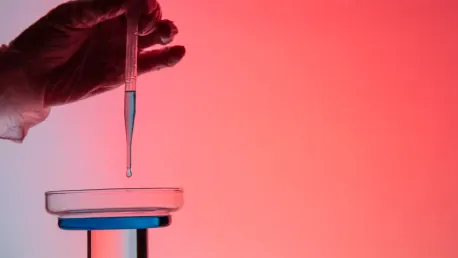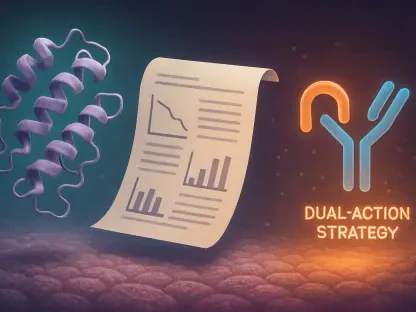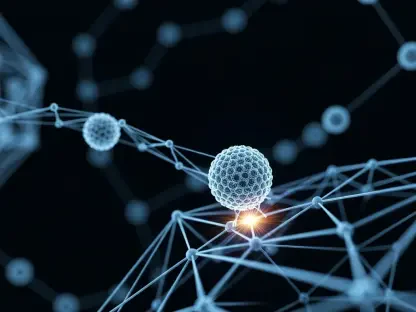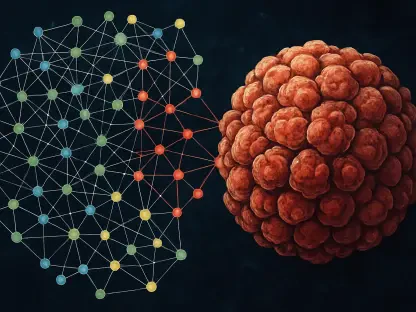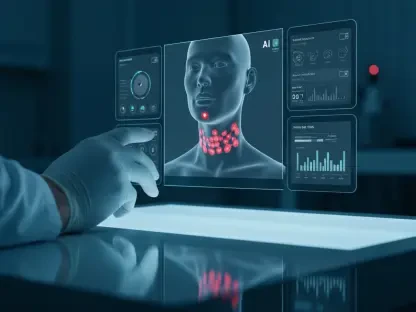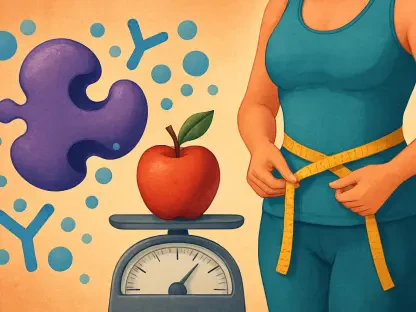The field of tissue engineering and regenerative medicine has witnessed a groundbreaking advancement with the development of the High-throughput Integrated Tissue Fabrication System for Bioprinting (HITS-Bio) by researchers from Penn State. This innovative technology promises to transform the landscape of bioprinting by significantly enhancing the speed and precision of tissue fabrication, addressing long-standing challenges in the field.
The Promise of Bioprinting
The Evolution of 3D Printing in Medicine
Three-dimensional (3D) printing has revolutionized various industries with its ability to rapidly produce material products. Extending this capability to the field of medicine, bioprinting offers potential applications in the fabrication of human tissue for transplantation, studying disease progression, and drug screening. By allowing researchers to recreate complex structures, bioprinting holds the promise of advancing personalized medicine and regenerative treatments. However, traditional bioprinting techniques have faced significant hurdles in achieving high cell density and scalable production, limiting their broader application.
In the medical field, effective fabrication of tissues depends on the precise placement and viability of cells. Traditional methods often struggle with maintaining these parameters, leading to compromised functionality. The challenges include damage to cell structures during the printing process and imprecise control over the placement of cells. Consequently, the effectiveness of these methods is constrained, hindering the creation of functional tissues required for clinical applications. Addressing these hurdles is crucial to realizing the potential of bioprinting in the medical landscape, which is where the HITS-Bio technology aims to make a transformative impact.
Challenges in Traditional Bioprinting
The limitations of existing bioprinting techniques primarily revolve around maintaining cell viability and ensuring precise control over cell placement. During the printing process, cells can be damaged, reducing their ability to form functional tissues. Additionally, imprecise cell placement can lead to the creation of tissues that do not meet the necessary criteria for clinical applications. These issues collectively result in a reduced ability to produce high-quality, functional tissues at a scale required for practical medical use.
Furthermore, traditional bioprinting methods often cannot achieve the cell density necessary for crafting functional tissues. This limitation restricts their application in regenerative medicine, where high cell density is paramount for tissue functionality. Simply put, without overcoming these challenges, bioprinting cannot fulfill its promise of revolutionizing medical treatments. The arrival of the HITS-Bio technique represents an innovative step forward in addressing these critical issues, paving the way for more effective and scalable bioprinting solutions.
The HITS-Bio Breakthrough
Introduction to HITS-Bio Technology
Penn State researchers have introduced a novel solution to the challenges plaguing traditional bioprinting with the HITS-Bio technique, which promises to revolutionize the field. This groundbreaking approach leverages spheroids, clusters of cells, to enhance both the precision and scalability of tissue fabrication. By utilizing spheroids, the researchers have significantly improved the speed of bioprinting, achieving a rate ten times faster than existing methods while maintaining high cell viability. This represents a substantial leap forward in tissue engineering and regenerative medicine.
The innovative use of spheroids allows for more precise control over cell placement and reduces the risk of cell damage during the bioprinting process. This precision ensures that the fabricated tissues are viable and functional, meeting the necessary criteria for clinical application. Moreover, the scalability of this method addresses one of the main limitations of traditional bioprinting techniques, making it possible to produce tissues on a larger scale. The success of HITS-Bio demonstrates its potential to transform the field of bioprinting and open up new possibilities for medical research and treatments.
Mechanism of HITS-Bio
The HITS-Bio system employs a digitally controlled nozzle array designed to manipulate and place multiple spheroids simultaneously, revolutionizing the bioprinting process. Organized in a four-by-four configuration, the nozzle array can pick up and place 16 spheroids at a time onto a bioink substrate with remarkable efficiency and precision. This advanced capability not only accelerates the bioprinting process but also ensures that over 90% of the cells remain viable, maintaining the integrity and functionality of the fabricated tissues.
The meticulous control offered by the digitally controlled nozzle array allows for the precise placement of spheroids, minimizing cell damage and ensuring the accurate formation of tissues. This method stands in stark contrast to traditional techniques, which often struggle with precision and viability. By maintaining high cell viability and enabling rapid production, the HITS-Bio technique significantly advances the potential of bioprinting in creating functional tissues for medical applications. This technological breakthrough is set to have a profound impact on the field of regenerative medicine.
Practical Applications and Testing
Fabrication of Cartilage Tissue
In testing the revolutionary HITS-Bio platform, researchers successfully fabricated a one-cubic centimeter cartilage tissue structure in under 40 minutes, a remarkable improvement over existing techniques. This structure, composed of approximately 600 spheroids, demonstrated the rapid and efficient production rate achieved by the HITS-Bio technology. The ability to produce such a structure in a fraction of the time required by traditional methods highlights the immense potential of this innovative bioprinting system.
The rapid fabrication of cartilage tissue showcases the practical applications of the HITS-Bio technique in regenerative medicine. By enabling the swift and accurate creation of functional tissues, this technology holds promise for addressing various medical conditions that involve tissue damage and loss. Furthermore, the success of these tests provides a strong foundation for future research and development, expanding the potential uses of bioprinting in clinical settings. The HITS-Bio technique represents a significant step forward in making bioprinting a viable option for medical treatments.
Intraoperative Bioprinting Experiment
Further illustrating the practical applications of their technology, the Penn State team conducted an experiment involving on-demand tissue repair in a surgical setting with a rat model. They printed spheroids directly into a wound site on the skull during surgery, marking the first instance of intraoperative bioprinting of spheroids. By programming the spheroids to differentiate into bone cells using microRNA technology, which controls gene expression, they significantly accelerated the healing process. The wound achieved 91% healing after three weeks and 96% healing after six weeks.
The success of this intraoperative bioprinting experiment demonstrates the potential of the HITS-Bio technique in real-world medical applications. The ability to print and repair tissue during surgery opens up new possibilities for treating various injuries and conditions. This breakthrough could lead to the development of personalized, on-demand treatments that significantly improve patient outcomes. The rapid healing observed in the experiment highlights the efficacy of the HITS-Bio method, paving the way for its adoption in clinical practices.
Future Implications and Research
Potential for Complex Tissue and Organ Fabrication
The implications of the HITS-Bio technique are vast and promising, offering new avenues for the creation of complex and functional tissues on a scalable level. This innovative method has the potential to revolutionize the production of larger and more intricate tissues, such as organs and organ tissue (e.g., liver), which are critical for advanced regenerative medicine applications. By addressing the limitations of traditional bioprinting techniques, HITS-Bio opens up the possibility of creating clinically viable tissues for transplantation and other medical uses.
The research team’s ongoing focus is on incorporating blood vessels into the fabricated tissues, which is crucial for creating types of tissues that can be used clinically or for transplantation. Initial demonstrations did not require this aspect, as cartilage does not contain blood vessels, and the surrounding blood vessels in surgical settings could support blood flow to bioprinted bone tissue. This continued research is essential for advancing the technology and expanding its applications, bringing closer the reality of bioprinting functional organs for medical use.
Interdisciplinary Collaboration and Support
The field of tissue engineering and regenerative medicine has made a groundbreaking advancement with the creation of the High-throughput Integrated Tissue Fabrication System for Bioprinting (HITS-Bio) by researchers at Penn State. This cutting-edge technology is poised to revolutionize the realm of bioprinting by dramatically increasing the speed and precision of fabricating tissues. Bioprinting has faced significant challenges, including the lengthy process and the difficulty in achieving high precision. The introduction of HITS-Bio addresses these long-standing issues, offering a promising solution.
With HITS-Bio, the time required for tissue fabrication is greatly reduced, which could accelerate research and development in regenerative medicine. This system allows for more accurate reproduction of complex tissue structures, crucial for advancing medical treatments. Additionally, the precision of HITS-Bio ensures that the fabricated tissues more closely mimic natural tissues, improving the potential for successful clinical applications. The development of HITS-Bio represents a significant leap forward, potentially transforming patient care and opening new avenues for research and innovation in tissue engineering and regenerative medicine.
